Blog Archives
Two fairy-wrens amid the eggs and bacon flowers
Fairy-wrens are pretty little puffs of feathers, with long tails that stick up into the air rather endearingly. They move fast and are notoriously difficult to photograph. Most of my fairy-wren photos end up as blurs. This morning, I was luckier.
The fairy-wrens in our area are Variegated Fairy-wrens. Here’s a male, with his stunning coat of blue, black, rusty red, and creamy-white:
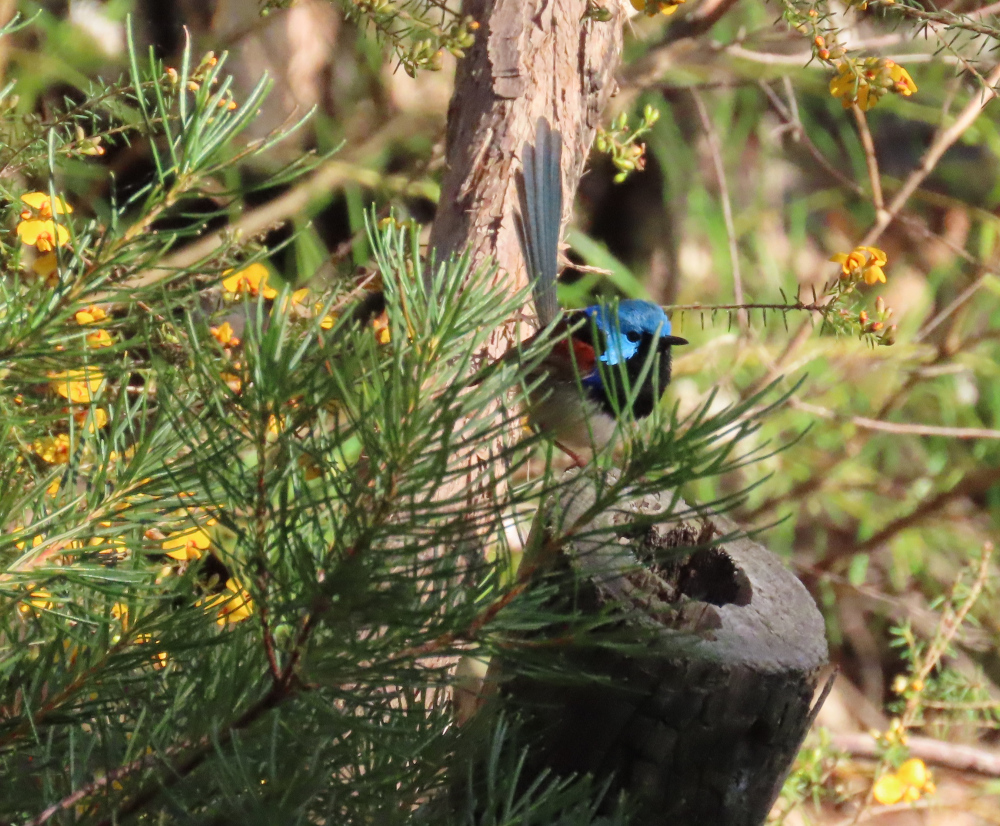
The flowers are, I think, Dillwynia elegans — also known as the Eggs And Bacon Flower or Parrot Pea. These flowers are tiny, but look a decent size next to the little wrens.
Here’s the female (or perhaps a juvenile), with her red eye mask and muted brown colouring. In the right light, her tail gleams a soft blue:
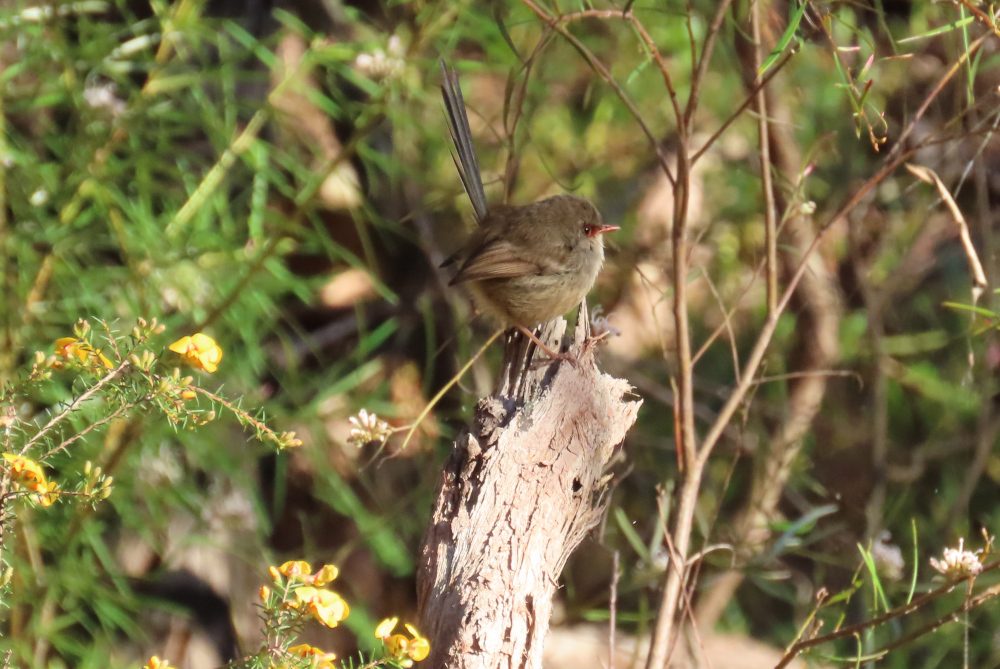
Common name: Variegated Fairy-wren
Scientific name: Malurus lamberti
Approximate length: 13 cm
Date spotted: 29 August 2025 (winter)
Location: Manly Dam park, near Sydney: 33°46’53.5″S 151°15’01.8″E
Learning how to be a Yellow-tailed Black Cockatoo
Strolling along a path at Manly Dam, I came across a group of Yellow-tailed Black Cockatoos. It’s always a treat being with these birds. They’re the quiet giants of the cockatoos in south eastern Australia. They sit on Banksia trees or, in this case, Casuarinas, chewing the seeds and chuntering to each other. Occasionally, one of the birds floats up into the air and glides to another branch.
In the group were two juveniles, making that almost-constant crooning noise that characterises them. I think it’s partially a request for food, and partially a reminder to the adult birds of where the little ones have got too.
This youngster hasn’t quite figured out what to do with a Casuarina seed pod. He finds one on the ground, touches it to his beak, then drops it. Nearby, an adult shows him how it’s done:
A little later, the youngster has climbed into a tree. Instead of tackling those hard seed pods, though, he practices wielding his beak on the bark:
Common name: Yellow-tailed Black Cockatoo
Scientific name: Calyptorhynchus funereus or Zanda funereus
Length: 58-65 cm
Date spotted: 24 July 2025 (winter)
Location: Manly Dam Reserve, New South Wales, Australia: 33°46’42.5″S 151°14’59.1″E
Did a street sweeper do this beautiful job?
A meticulously-raked verge. The busy sounds of sweeping. Is there an ace street sweeper at work?
Common name: Australian Brush-turkey
Scientific name: Alectura lathami
Approximate length of adult bird: 60-70 cm
Date spotted: 12 July 2025 (winter)
Location: Manly Dam, New South Wales, Australia: 33°46’59.5″S 151°15’18.2″E
Pacific Baza chased by cockatoos
I was walking along Forty Baskets Track on Sydney Harbour when the Sulphur-crested Cockatoos started making an enormous ruckus. They took to the sky in a large flock and circled overhead screaming blue murder.
When I managed to find a gap in the tree canopy, I saw that the cockatoos were chasing a large bird of prey:
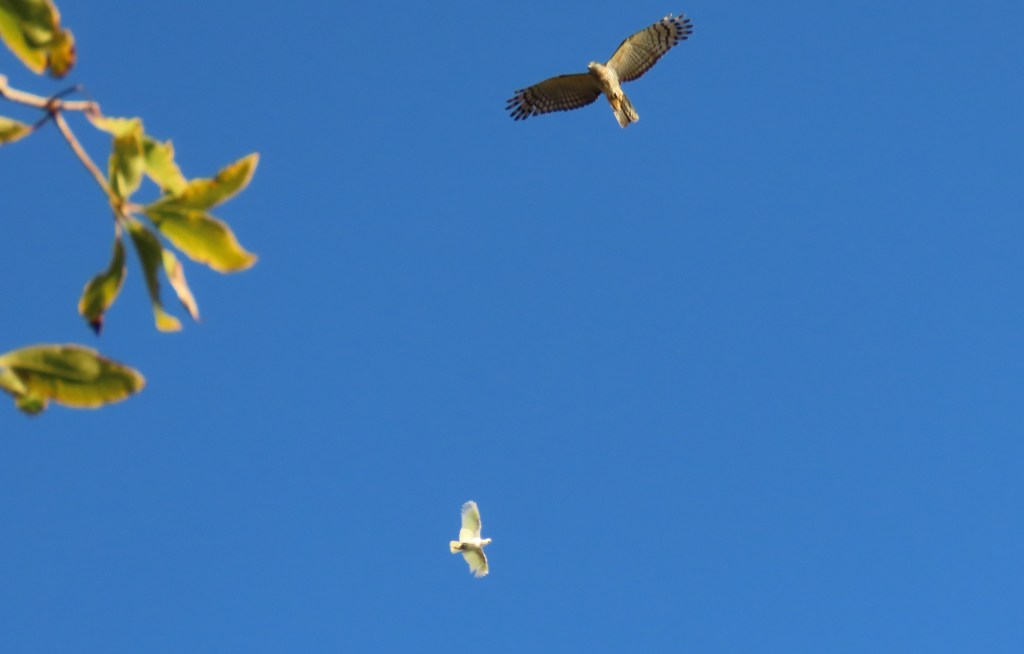
I followed the pack of birds for about 15 minutes, back and forth along the track. The bird of prey landed in the tree tops a few times, and I was able to identify it as a Pacific Baza. I managed to see the crest on its head, but didn’t get a good enough photo of the crest to post here. This is the best photo I got of the bird at rest:

Pacific Bazas are uncommon, mostly found in north and north-east Australia, and are rare in New South Wales (where I am). They eat small reptiles, and praying mantises and stick insects (both of which can be quite large in Australia).
Common name: Pacific Baza
Scientific name: Aviceda subcristata
Length: 35-45 cm
Wing span: 1 metre
Date spotted: 29 June 2025 (winter)
Location: Forty Baskets Track, Balgowlah, NSW, Australia: 33°48’18.2″S 151°16’18.2″E
White-faced Heron stretching
In the morning sun, a White-faced Heron stretches his wing. The decaying wood of his perch mirrors the pattern of his stretch.

Common name: White-faced Heron
Scientific name: Ardea novaehollandiae
Approximate length: 66-69 cm
Date spotted: 20 June 2025 (winter)
Location: Manly Dam, New South Wales, Australia: 33°46’34.0″S 151°14’48.5″E
Neat Spotted Pardalote
Spotted Pardalotes are tiny little birds with neat patterns and colours on their heads and bodies. They flit around high in the trees or deep in the undergrowth, so it’s a treat when one stays still long enough to get a good look at you.
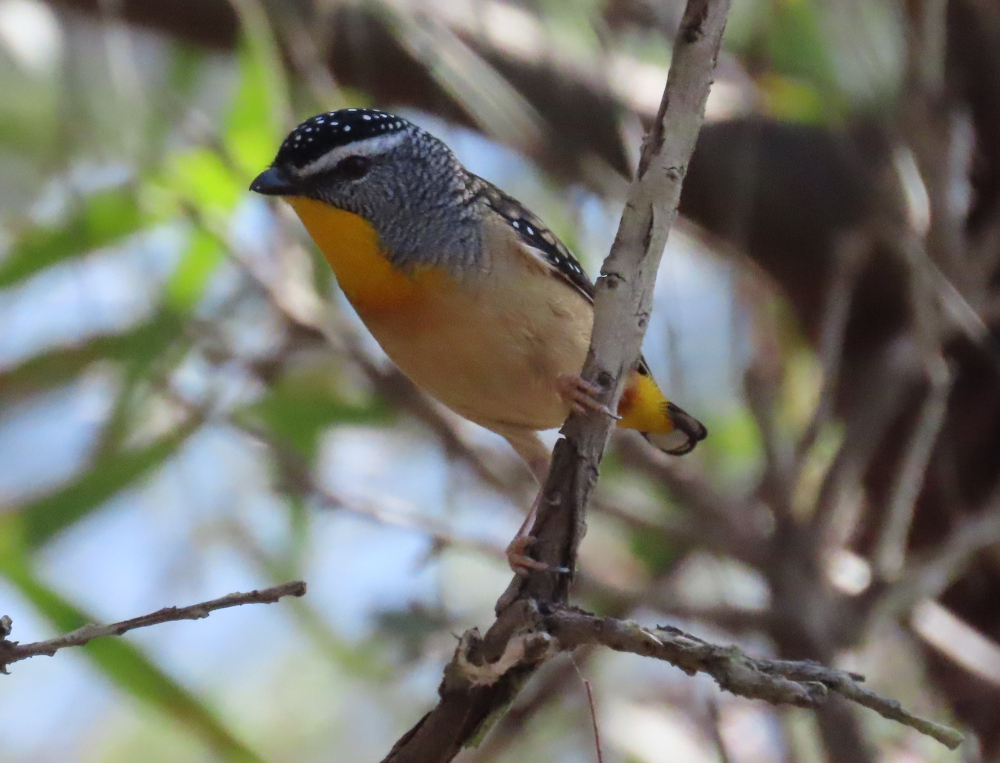
Pardalotes are native to Australia. There are four species in the Pardalote family, of which we have just one in our area near Sydney.
An unusual characteristic is that, although they spend much of their time high in the treetops, they build their nests in tunnels in the ground. Take a look at my other posts to see videos of these birds entering into and emerging from their tunnels.
Common name: Spotted Pardalote or Diamondbird
Scientific name: Pardalotus punctatus
Approximate length: 10 cm
Date spotted: 19 June 2025 (winter)
Location: Manly Dam, NSW, Australia: 33°46’38.6″S 151°14’55.8″E
Two songs of the Fan-tailed Cuckoo
I’ve heard Fan-tailed Cuckoos several times over the years, making their pretty downward trilling call. A few days ago, I heard a different call: a haunting, mournful whistle sighing in the mist.
In this 14-second video, the bird whistles five times:
At first I didn’t know what type of bird was calling. Then I saw a Fan-tailed Cuckoo fly onto a nearby branch:

They’re rather pretty birds, with a russet chest and belly, and a startling orange mouth. On this occasion, I could see only the back of the bird. Here’s a picture of another Fan-tailed Cuckoo, which I saw in June 2020:
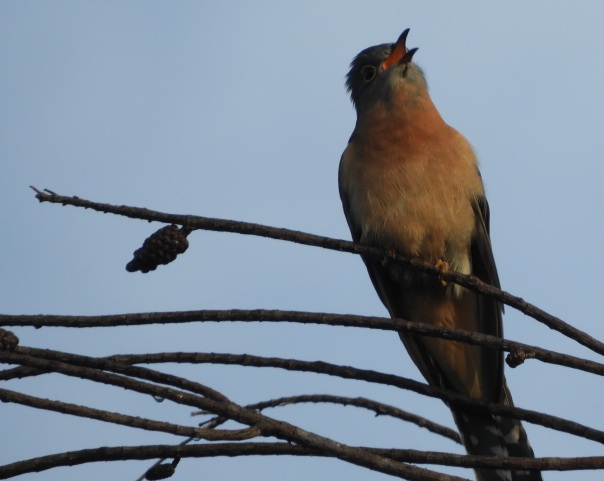
Shortly after I heard the whistles, the same bird or another started making the typical trilling call that I’ve heard more often. In this 17-second video, the bird calls four times:
Common name: Fan-tailed Cuckoo
Scientific name: Cacomantis flabelliformis
Approximate length: 26 cm
Date spotted: 11 May 2025 (autumn)
Location: Manly Creek, New South Wales, Australia: 33°46’21.3″S 151°14’34.8″E
Muscovy ducks meet a Brush-turkey
Two Muscovy ducks hiss and wag their tails to warn off an Australian Brush-turkey. The Brush-turkey had been investigating my shoes, then it decided to see what the two interesting ducks were up to. The encounter ends peacefully. No feathers flying this time!
Muscovy ducks come from the Americas, and are actually more like a cross between a goose and a duck than just a duck. They hiss like geese, although it’s a very quiet hiss. Their faces and heads look like geese, but their body shape is more like a duck’s.
I’ve seen this pair of Muscovies at Manly Dam often — they’ve made this area their home.
Common name: Australian Brush-turkey and Muscovy duck
Scientific name: Alectura lathami (Brush-turkey) and Cairina moschata (Muscovy)
Approximate length: 60-70 cm (Brush-turkey) and 76–84 cm (Muscovy)
Date spotted: 29 April 2025 (autumn)
Location: Manly Dam park, New South Wales, Australia: 33°46’44.9″S 151°14’58.4″E
Little Corella enjoying a snack
This Little Corella was one of a group enjoying a tasty snack (fruit from a nearby fir tree of some kind):
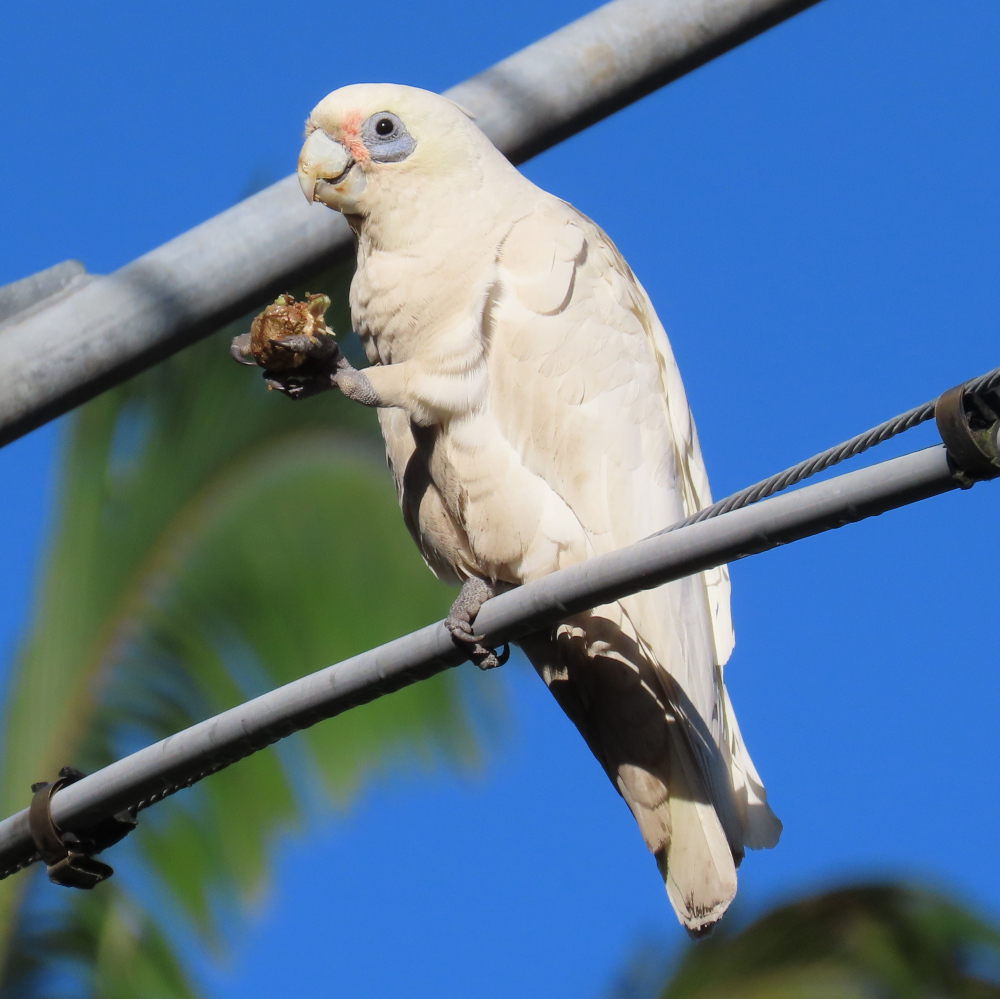
People have a love-hate with these birds. On the one hand, corellas are cute, pretty, and smart. On the other hand, they’re noisy and fiendishly good at destroying property!
Common name: Little Corella
Scientific name: Cacatua sanguinea
Approximate length: 36-39 cm
Date spotted: 22 April 2025 (autumn)
Location: Balgowlah, New South Wales, Australia: 33°47’57.2″S 151°15’50.9″E
Osprey nests at Rat Park
For a couple of years, I’ve been reading about the Ospreys that nest high on the lights at Rat Park in Warriewood, in Sydney’s Northern Beaches. The birds have earned their fame by returning year after year to the same spot. They build their nests and raise their young in what seems an unlikely and uncomfortable perch, twenty metres above the playing fields. So I went to take a look at them.

Ospreys are magnificent birds, with their large size and impressive fishing skills. They’re listed as vulnerable in NSW. Their numbers were in decline until the 1970s, but the great news is that they’re on the rise now.
Here’s a close-up of the same Osprey on the lamp post:

This photo shows the same nest from the other side:
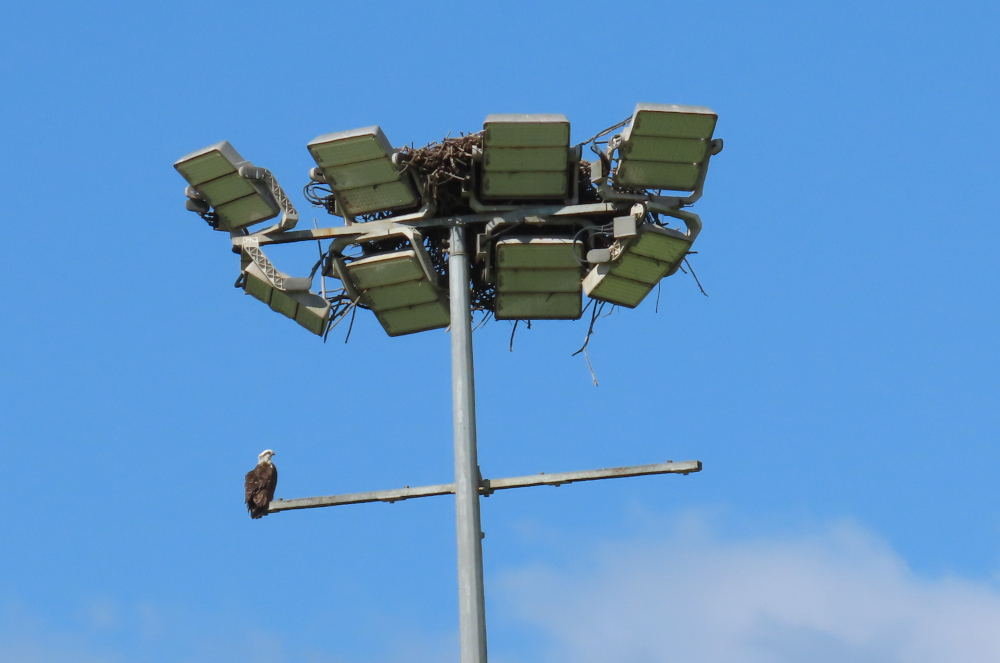
Zooming out to show the playing field and the 20-metre lamp post with the nest on top:

There were nests on top of a couple of the other lamp posts too, but no Ospreys tending them while I was there.
Here’s a front view of the Osprey with the sun behind it:
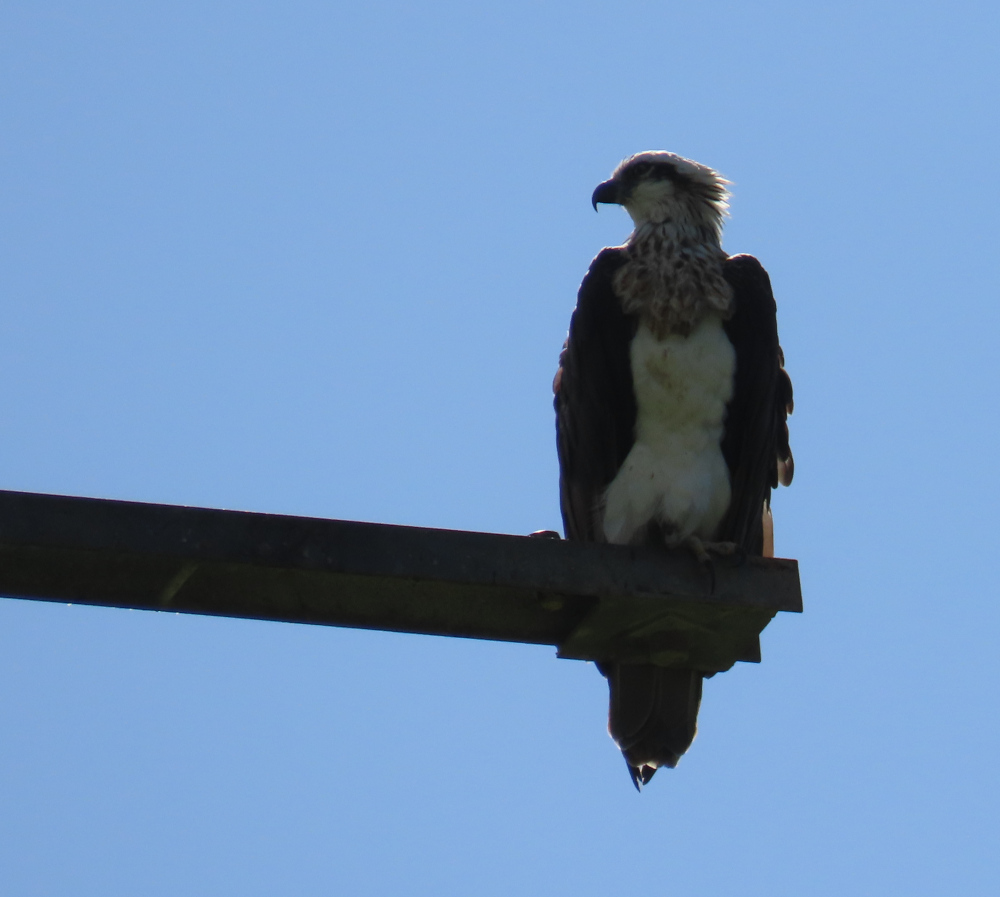
I’ve been lucky enough to see Ospreys a few times, most often at the Long Reef Aquatic Reserve in Collaroy. The Manly Observer has reported on the Ospreys of Rat Park, and they’ve featured on several other sites including Facebook.
Common name: Eastern Osprey
Scientific name: Pandion cristatus
Approximate length: 57 cm
Date spotted: 4 April 2025 (autumn)
Location: Rat Park, Warriewood, New South Wales, Australia: 33°41’50.6″S 151°18’21.8″E






